This poem was originally a contribution to Tania Kovats' film COTIDAL - but we thought it and its film deserves a place of its own.
Everything is connected. In May 2013 Transition Town Louth held the Louth Festival of the Bees, an art exhibition, conference, operatic concert and more, which connected bees and wildflowers, arts and science, to promote aspects of the environmental crisis that humanity faces. The Festival brought us into contact with sculptor Marcus Vergette who was looking for an east coast site for another Time and Tide Bell. Soon Marcus was with us, scoping locations along the Lincolnshire coastline.
Our beaches are a contrast to the other Bell locations, wide open expanses of sand and big skies, a deep history of shifting coastlines over centuries and millennia and a future whose only certainty is deep uncertainty. The Time and Tide Bell produced an opportunity to start conversations about our relationship with the seas, back into unfathomable time and forward to the time from which we have no evidence, not so much as a stone tool or bone fragment, because it has not yet been.
The past is the history of ice ages and sea level changes, to which people have adapted. The future will be the product of human influence, global heating and sea level rise. Our ability to adapt will be tested. The Bell looks out over Doggerland, the vast plain that, in Mesolithic times, was home to countless people, its lakes, rivers and shores, providing rich resources. The uplands of that plain are once again being built upon but now with wind-farms, substituting fossil fuels with renewable energy.
The gas pipelines that cross the beach near the Bell are now shut down, the southern North Sea gas fields emptied of their methane, burnt in our homes and factories, the carbon dioxide vented to the atmosphere. This has contributed to changing the air’s composition from 280 to 415 parts per million of carbon dioxide. We need to revers that. It is not enough to reduce our carbon emissions; the damage must be undone.
To install the Bell on our beach we formed the Lincolnshire Time and Tide Bell Community Interest Company, but that was just our first objective. Our continuing task is to create a programme of art exhibitions and events that engage people with aspects of the natural environment, fusing the arts with the sciences and using the arts as a tool to promote mitigation and adaptation to the consequences of global heating.
Our major events so far and planned:
- May 2018 Across the Seas. Art exhibition at The Sam Scorer Gallery, Lincoln, investigating migration, past, present and in the future.
- August 2018 #200Fish. Art exhibition at The North Sea Observatory drawing attention to the over 200 species of fish found in the North Sea.
- November 2018 By the Sea. Art exhibition at The North Sea Observatory inspired by the coastal environment.
- June 2019 Installation of the 7th Time and Tide Bell on the beach within the Saltfleetby-Theddlethorpe National Nature Reserve.
- August 2019 Warming Bells. Art exhibition at The North Sea Observatory, drawing on the cultural heritage of bells to sound a warning about the climate emergency.
- March 2020 Faces of Climate. Art exhibition at The North Sea Observatory, portraits of climate scientists and activists.
- November 2020 Doggerland. Symposium and art and archaeology exhibition at The North Sea Observatory, exploring the flooding of Doggerland and future sea level rise.
Photographer Mark Kerton (whose YouTube channel is here), got up early to take these beautiful images of the Mablethorpe bell.
The Mablethorpe bell is the only one mounted on a beach. It is fixed to large 'helical piles', which like large corkscrews are driven deeply into the sand; this is a common way of mounting structures on sand.
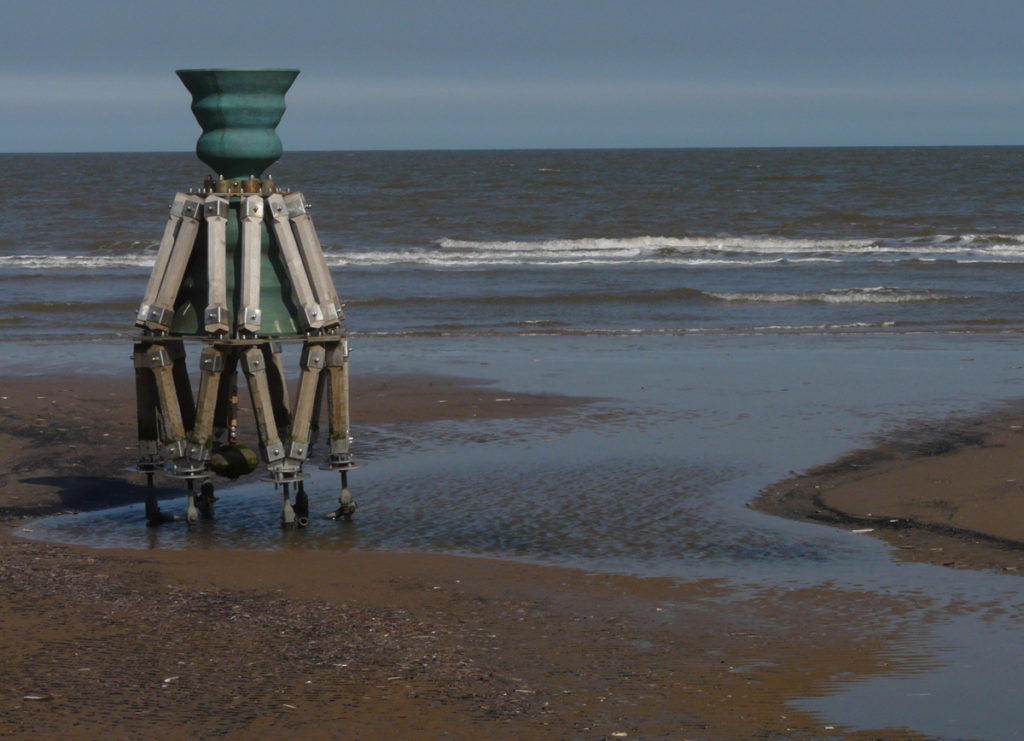
Anyone who has visited the bell may have noticed various levels of the sub-structure being revealed by shifts in the sand level. It seems that when the bell was installed the sand was at a relatively high level. but for various reasons it has changed: natural seasonal variations, the impact of large scale sand pumping just off shore, and more.
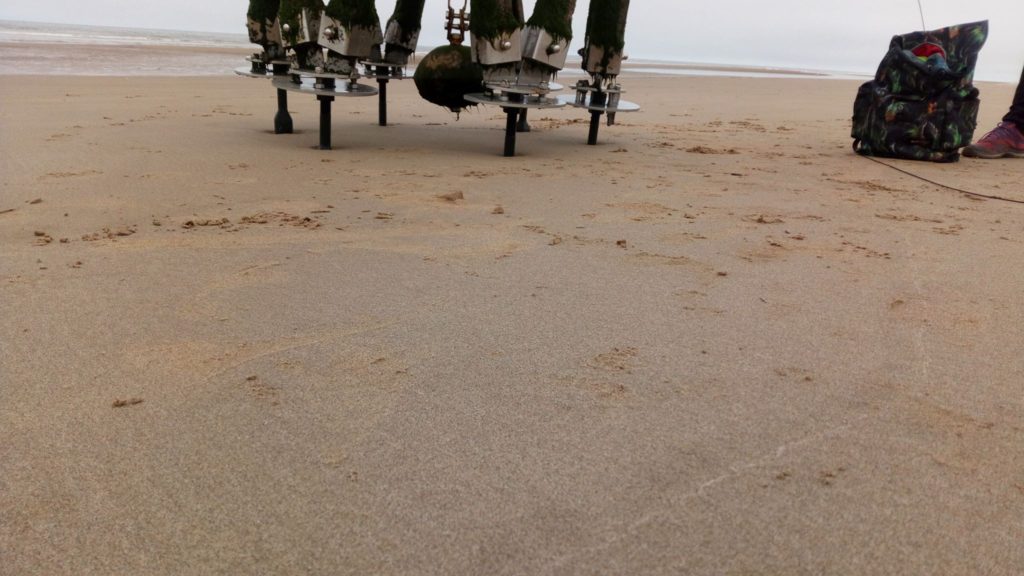
This necessitated some remedial work early in 2020.
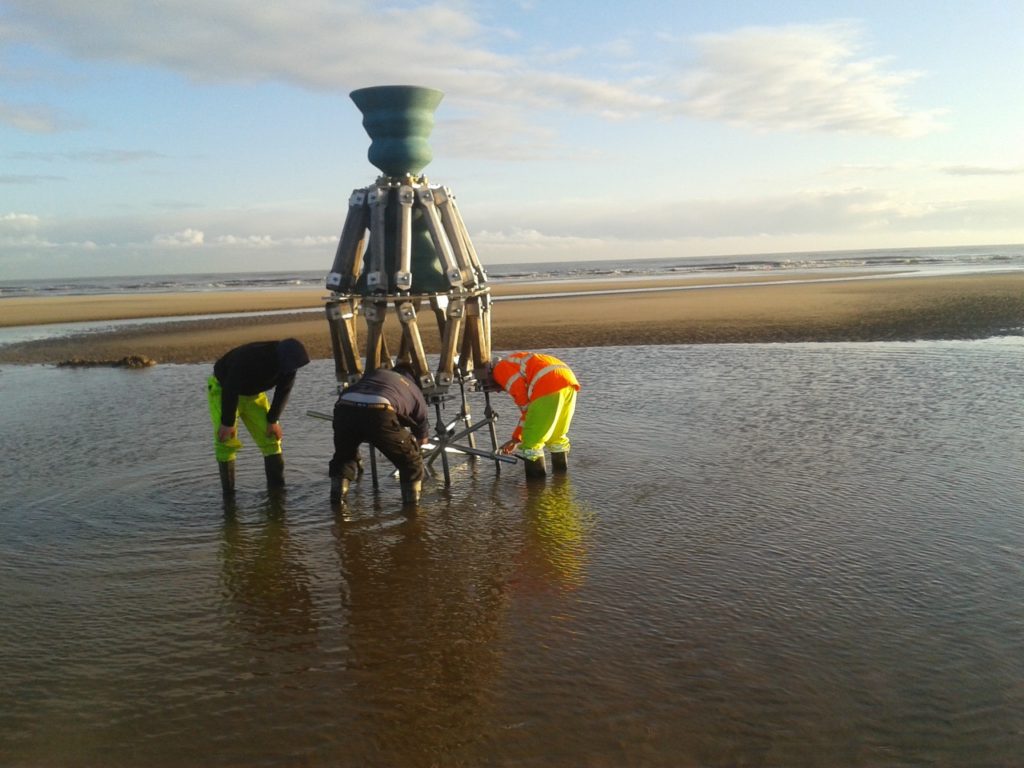
But since then the level has risen. Time will tell where it ends up.....
We are continuing to develop our Citizen Science programme, after the long break enforced by the lockdown, furloughs, etc etc.
At the heart of this project is the enormously powerful tool iNaturalist. We have created what the platform calls a 'place' - see below. It is deliberately somewhat larger than the immediate environs of the bell.
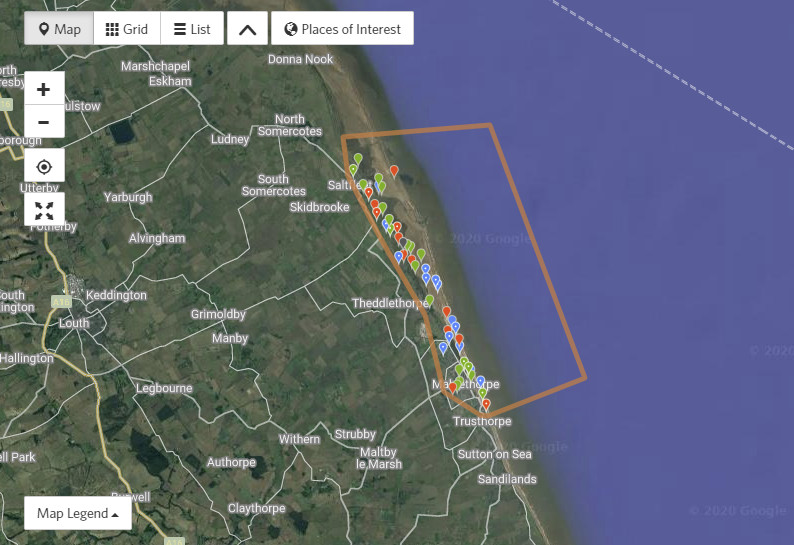
Within that place we have created a 'project', which will be central to data collection in the area. Much the best way to explore that is to use iNaturalist itself - see the link to the project here.
Having said that, examples of the observations are presented below. Click on any of the observations for more details.
A group met on the beach to kick the project off on March 4th, 2020.
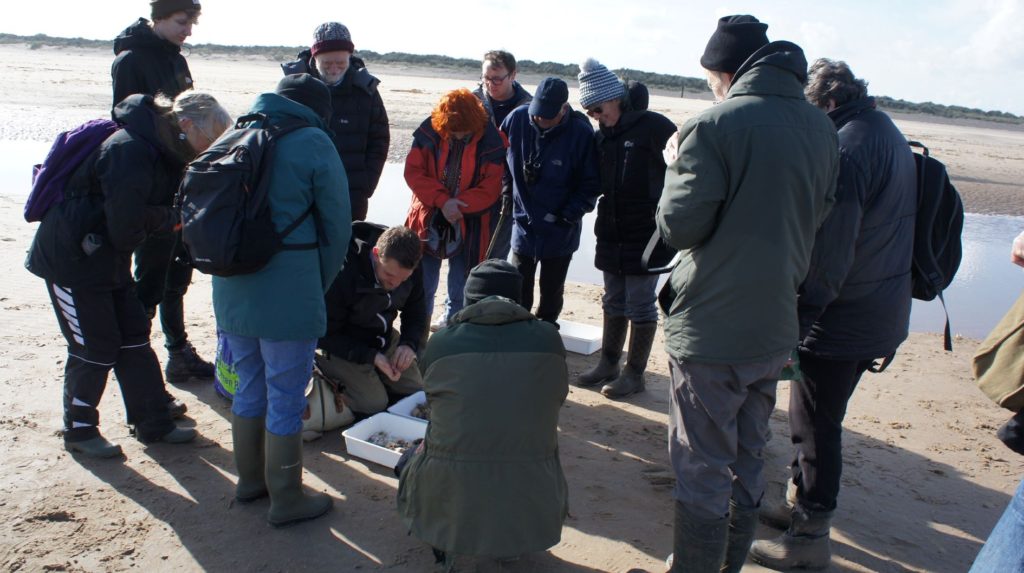
A piece composed by Peter Conner and Andy Aitchison using the haunting sound of Marcus Vergette's Time and Tide Bell installation on Mablethorpe beach.
On March 4th 2020 about 20 people assembled at the Ferryboat Inn (many thanks to Golden Sands Holiday Park for lending it to us) to explore Citizen Science possibilities. As with our other meetings this was very ably led by Jack Sewell of the Marine Biological Association.

The beach in Mablethorpe has rather different features to the sites of the two previous workshops; above all, there is a plethora of shells, which made for a fascinating comparison.
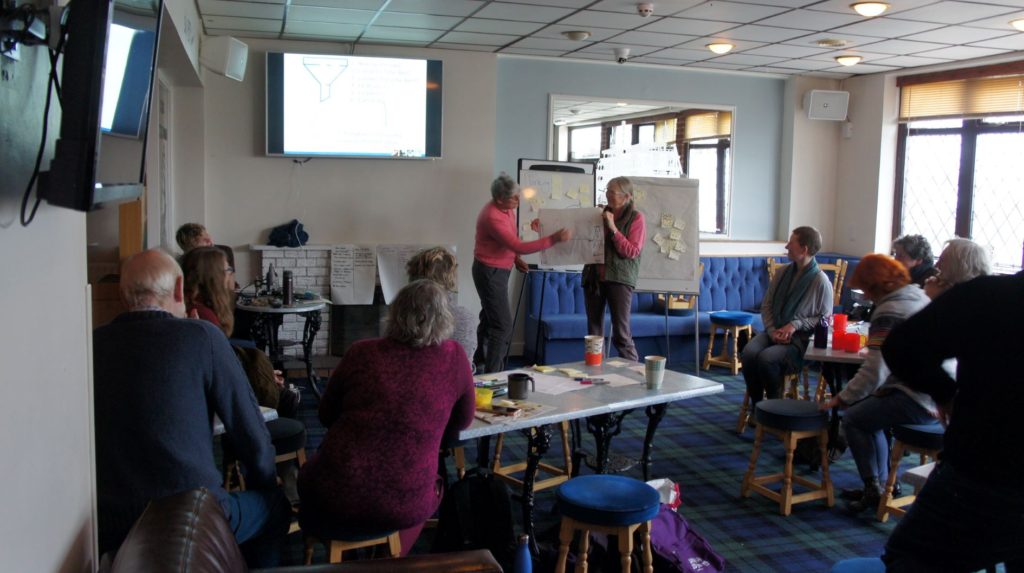
The aim of the game was to develop ideas, inspired and put forward by the local community, for projects that could be explored by all age groups. Plenty emerged - and after a process of distillation the results will be shared with whoever wants to engage with them. Stand by...
This bivalve is widespread in coastal waters and on the ocean shelves of the North Atlantic. In North America it is usually called the Ocean Quahog (pronounced ko-hog).
Arctica islandica dates back to at least the early Cretaceous about 135 million years ago. Individual Icelandic Cyprines live for hundreds of years, the oldest living non-colonial animal known. One specimen was 507 years old when it died. Their shells have growth lines rather like trees, which record the years and the environmental conditions. They are being studied to help reconstruct as sequence of climate changes in the past.
Our greenhouse gas emissions not only cause global heating and sea level rise, the increased carbon dioxide absorbed by the oceans' waters leads to acidification, a lowering of the sea water's pH. This will have devastating effects on ocean biodiversity, making a major contribution to the Sixth Mass Extinction, the beginnings of which we are now witnessing. The Icelandic Cyprine, however, can survive high levels of CO2 in the water, having survived the end-Cretaceous mass extinction and the Paleocene-Eocene Thermal Maximum (PETM) 55 million years ago. Even if we manage to drive our own species to extinction, this little clam is likely to survive us.
Look out for Arctica Islandica on the beach. You might walk over a thousand cockles, mussels, oysters, razor clams, piddocks, tellins and gapers before spotting an Icelandic Cyprine, but when you do, it may be the shell of the oldest creature you've ever seen. And it's descendants may have a longer future than humanity.
The Lincolnshire Bell lies at the heart of an impressive range of arts activity, led by the Lincolnshire Time and Tide Bell CIC's Artistic Director, Biff Vernon. This example is of Warming Bells, an exhibition at the North Sea Observatory, Chapel Point, Lincolnshire, in August-September 2019, with the following theme:
We are a group of artists and arts promoters who recognize the potential existential threat of global warming and are determined to use the arts to communicate our concerns to our audiences.
To keep up with what else is happening, and the group's broader arts programme, follow both their website and their Facebook page.
Short film about the inauguration of the Mablethorpe bell and what the wider project means. We have used it to describe the ethos of the whole project more widely.
The bell's setting, on the wide and long beach running North from Mablethorpe is enormously striking - at all states of the tide it stands out in an enormous expanse of sand and water.
The nearest road and car-parking is at North End, Mablethorpe by the Ferryboat Inn and Seal Sanctuary. Bus routes 51 and 59 from Lincoln and Skegness stop here. Take the path next to the pub to cross the dunes. On the beach turn left, northwards. The bell will be in sight, about 10 minutes' brisk walk up the beach. The Bell can also be reached from the Crook Bank car-park, approached from Theddlethorpe. It's an interesting walk across the dunes.
The bell installation took place in horrible weather, with help from a team from Van Oord and contractors Groundsun. The seventh bell of the series, it is the first to be installed on a sandy beach, which required a new form of mounting to the project.
The installation was the result of an enormous amount of work by the Lincolnshire Time and Tide Bell CIC, particularly Biff Vernon.



